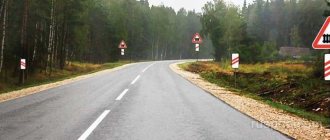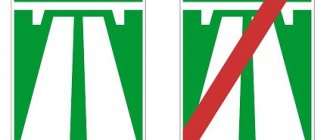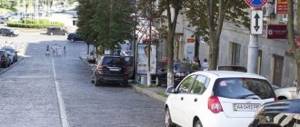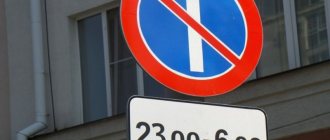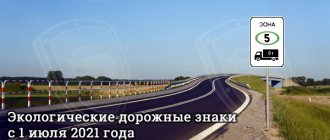Major changes
Some road signs have undergone amendments to the rules. Major fixes:
- Limiting the movement of cyclists;
- Prohibition on entering a limited area without a pass;
- Several familiar signs will disappear from the road;
- Limiting the movement of equipment with large emissions of harmful substances;
- Areas adjacent to diplomatic missions will be specially designated;
- Intersections will become clearer thanks to traffic regulations during traffic jams;
- Paid parking will be marked with a blue line;
New road signs will appear:
| Number and name | Image | Number and name | Image |
| 1.35 "Crossroads Section" | 3.34 “Bus traffic is prohibited” | ||
| 5.14.2 "Lane for cyclists" | 5.14.4 "End of lane for cyclists" | ||
| 5.39 "Bicycle zone" | 5.40 “End of the bicycle zone” | ||
| 7.14.1 “Customs control point” | 8.9.3 “Parking for diplomatic vehicles only” | ||
| 8.25 “Ecological class of the vehicle” | 8.26 “Charging electric vehicles” |
New lane direction signs from 2021
There are numerous signs regulating the order of traffic on the lanes. Let's look at their examples:
Please note: the first sign indicates a lane for route vehicles, the second indicates a left turn into the second carriageway in order, and the third sign indicates tram tracks.
New possible variants of sign 5.15.2:
As you can see, there are many more variations of arrows to cover all possible intersection configurations.
For example, a sign means that turning left into the first two lanes is prohibited.
Let us describe the meaning of the signs:
| An additional lane begins on the left from which you can turn left |
| An additional lane starting from the left is intended for turning |
| Traffic lanes start on the left and right. On the right, the speed limit is 50 km/h. |
| Traffic lanes start on the left and right. The left lane is for turning left, the right lane is for turning right. On the right, the speed limit is 50 km/h. |
| The lane on the right ends |
| The lane on the left ends |
Rules for moving heavy vehicles
For equipment weighing more than 3.5 tons and above, a new sign is introduced that limits the size of vehicles with a weight control zone. There will be two types of signs - a regular one, marking the control zone, and a crossed out one, marking the end of the control zone. In areas where such a road sign will be installed, heavy vehicles will be prohibited from:
- Stop on the side of the road;
- Travel with dirty or missing registration plates;
- Stopping and turning around are also prohibited;
- Using powerful searchlights or spotlights.
In the area covered by the sign, you must maintain a distance of at least 20 meters from the nearest vehicle, observe the speed limit and move in your own lane.
“We are forced to use a navigator.” Why do we need a new road sign?
The green sign, which comes first in the general list, indicates that the driver is entering a section of the road where a special speed limit of at least 40 km/h is in effect.
In addition, highway traffic prohibits stopping and parking, reversing, turning and other maneuvers permitted on regular highways.
A crossed out highway sign indicates the lifting of previously existing restrictions. That is, this section provides for the movement of low-speed vehicles.
Only 2-wheeled and 4-wheeled cars and trucks traveling at a speed above 40 km/h can travel on roads. But there is definitely no place for pedestrians, carriages and special equipment here.
If a car on a blue background is crossed out with a red stripe, then all previous prohibitions automatically cease to apply. This means that any vehicle without exception can drive on such roads.
A crossed out sign warns the driver that he is entering a lane with oncoming traffic in one, two or more rows. As for the possibility of entering these lanes, it will depend on their number and the road markings in force in the area.
These signs also indicate a one-way exit; they indicate in which direction you will move after crossing the intersection.
So, for pointer 5.7.1 the actual movement is to the right, and for 5.7.2 – to the left. In any case, you should turn from the outermost lane corresponding to the given direction, occupying any of the free rows in a one-way section.
In such areas, the direction of movement is not constant; it is regulated by a reversible traffic light accompanying the sign. These optics switch in a certain mode, opening passage for one direction, and then for another.
The completion of such sections is indicated by sign 5.9. And it is after it that the free movement zone begins for vehicles traveling in both directions.
Addition to 2021 edits
Road signs for which the images have changed
| Number and name | Old look | The new kind |
| 5.35 “Zone with restrictions on the environmental class of motor vehicles” * | ||
| 5.36 “End of the zone with restrictions on the environmental class of motor vehicles” * | ||
| 5.37 “Zone with limited environmental class by type of vehicle” * | ||
| 5.38 “End of the zone with limited environmental class by type of vehicle” * | ||
| 6.4 “Parking (parking space)” | ||
| 7.21 “Gas station with the ability to charge electric vehicles” | ||
| 8.4.3.1 “Type of vehicle” | ||
| 8.4.15 “Except for the type of vehicle” | ||
| 8.9.2 “By parking permits” * | ||
| 8.9.4 “No parking permits” * |
In 2021, new restrictive signs for cars with different environmental classes appeared in the Russian Federation. This year 5 more signs will be introduced. They will restrict the movement of cars and other vehicles in the marked area that do not comply with the environmental class indicated on the sign.
New signs will make it possible to restrict the entry and passage of vehicles with a low environmental class into the marked areas. The new rules also apply to parking; they prohibit drivers from stopping their vehicle if it does not comply with the standards. If previously such signs were valid for cars that had an environmental class specified in their documents, then from 2021 these rules will apply to any vehicle. The rules are already spelled out in the traffic rules. For this violation, a fine of 500 rubles is imposed.
New sign “Photo and video recording”
Starting this year, a new information sign “Photo and video recording” will appear on the roads. It will be used to designate areas of possible use of special means that have the function of photo or video recording of traffic violations. Outside the populated area, the sign will be installed at a distance of 150-300 m before the start of the fixation zone. In populated areas only at the entrance along with a sign indicating the name of the populated area. The new sign will inform drivers about cameras on highways in advance, while the warning will disappear in populated areas.
If previously a sign with a camera image was installed only in conjunction with other signs such as: speed limit, prohibition of overtaking, etc., now it is installed independently of other signs. The “Photo and Video Recording” sign will replace signs with a camera image.
What is a “Pedestrian Crossing”?
Pedestrian crossing is a section of the roadway, marked with special signs and/or markings, intended for the movement of pedestrians in order to move from one side of the road to the other. In this case, we are talking exclusively about the ground crossing, since the overground and underground are specially created in order to separate the flow of transport and pedestrians.
All the difficulties associated with the topic under consideration are concentrated around the location and boundaries of the crossing - which zone is the crossing, where it begins and ends, crossing which boundaries will be considered for the driver as not allowing a pedestrian to pass.
Pedestrian Crossing Signs
“Pedestrian crossing” signs are a set of road signs indicating the location of the crossing or warning of its imminent appearance. These are three road signs at once - warning 1.22 and special instructions signs 5.19.1 and 5.19.2.
We will analyze each of them in detail, but first we note that the transition can be indicated by signs and markings, or only by signs, or only by markings. Depending on this, the border of the pedestrian crossing will be determined.
Sign 1.22 “Pedestrian crossing”
Let's start with a warning sign in order to close this issue and not return to it further in this article. It looks like this:
Road sign 1.22 “Pedestrian crossing”
It should be immediately noted that according to GOST R 52289-2019, both this sign and signs 5.19.1 - 5.19.2 can be made on boards with green-yellow reflective film:
Road sign 1.22 “Pedestrian crossing” with reflective film
This sign warns that there will soon be a pedestrian crossing. According to the mentioned GOST R 52289-2019, the sign is placed:
- Outside populated areas - in front of unregulated crossings.
- In populated areas - in front of the first unregulated one or in front of those whose direct visibility is less than 150 meters.
In other cases, it is permissible not to install this sign, i.e. its presence is not mandatory, and the pedestrian crossing will be such regardless of the presence of sign 1.22 in front of it.
Signs 5.19.1 and 5.19.2
These are signs that directly determine the transition. Certain difficulties begin already at the stage of describing the sign, because Not even all experienced drivers know that there are two such signs. Outwardly, they are very similar - a blue square with a white triangle inside, along which a pedestrian moves along a schematic zebra crossing.
A significant difference is the schematic representation of a human silhouette: on sign 5.19.1 it depicts movement from right to left, and on sign 5.19.2, on the contrary, from left to right :
Road sign 5.19.1 “Pedestrian crossing”
Road sign 5.19.2 “Pedestrian crossing”
Two signs are needed to determine the boundaries of a pedestrian crossing in the absence of markings . In such cases, 5.19.1 is placed to the right of the roadway and marks the beginning of the transition line, and 5.19.2 is placed to the left, marking the end of the transition zone. If there is a structurally designated dividing line, 5.19.2 is also installed on the left, but in the area of such a dividing line.
A typical case of defining transition boundaries using signs without markings:
If there is a marking, then it is this that defines the transition zone, and the signs should be installed at a distance of no more than 1 meter from the beginning / end of the marking.
8(800)350-23-68
Dmitry Konstantinovich
Expert of the site "Legal Consultant"
Ask a Question
Sometimes the question arises about the coverage area of the Pedestrian Crossing sign. In this case, it is the zone of the transition itself, which, if both signs are present, means that at 5.19.1 the transition begins, and at 5.19.2 it ends. In this case, the car stopping zone is 5 meters before the crossing.
What does the marking of pedestrian crossing 1.14.1 – 1.14.2 look like?
The final indicator that can determine the presence of a pedestrian crossing is markings. This is a zebra, familiar to everyone since childhood - continuous wide stripes perpendicular to the movement of pedestrians. However, they come in two types:
Markup 1.14.1
Markup 1.14.2
If there is marking, it is this that determines the width of the transition . This width is established by the standards of the already known new GOST R 52289-2019, which contains a formula for calculating this parameter, depending on the intensity of traffic. Wherein:
- The width cannot be less than 4 meters.
- Up to a width of 6 meters, marking 1.14.1 is used.
- Wider than 6 meters – marking 1.14.2.
Let's summarize. The crossing can be marked with signs, markings, or just one thing (another option for additional signaling is a traffic light, but we’ll talk about that later). If there is not a single distinguishing feature, such a place on the roadway is not a crossing, and crossing the road there will be considered a violation.
Parking ban
The new amendments also affected the parking of cars and other vehicles on traffic islands; starting from this year, it will no longer be possible to park in these places.
The coverage area of the “No Stopping” sign now ends immediately after the “Parking” sign. The rule according to which the “No Parking” sign loses its force in the area where the yellow markings have ended has been removed.
A new road sign will appear in Russia in March
Changes in the 2021 traffic rules concern personal mobility devices, which will have to be introduced into road traffic on a full basis. The new road user receives the name SIM. This is the name given to a device that has one or more wheels, and its movement is provided by a simple engine or muscle power. SIM can be electric scooters, hoverboards, unicycles, and Segways. And if we talk about devices that move by muscular force, these include skateboards, rollers, etc. The scope of SIM regulation does not extend to wheelchairs and bicycles, which are controlled by other measures.
Changes in traffic rules from January 1, 2021 will affect not only owners of electric scooters, roller skates, etc., but also motorists who own vehicles, therefore, while moving on the road, they must constantly adhere to the rules. The first change that will directly affect motorists is that it is forbidden to stop at traffic islands, where previously it was possible to safely park a car.
The next change that next year will bring us is the end of the “No Stopping” sign as soon as the “Parking” sign comes into view. The specifics of the operation of the “No Parking” sign are also changing. According to the new rules, its validity will end from the final point of the village or to the intersection.
All this leads to the fact that from January it will become more difficult for motorists to navigate, and they will have to learn several more new rules. In addition, the new rules will not be learned immediately, so there is a risk that due to violations regarding innovations, the number of fines will increase.
According to the new traffic rules that will be implemented in 2021, starting in January, all windows in a car can be tinted, but it is important that the front and side windows are tinted to allow at least 70% of light to pass through. The remaining windows can be tinted with any light transmittance factor.
Previously, this parameter was controlled more strictly. For example, the rear windows had to transmit at least 70% of the light, and the front 75%. These standards were introduced back in 1988.
Buses are the same members of the road traffic, but they have a higher responsibility, since this transport carries many people. According to the new rules, the bus can be accelerated to 90 km/h, as before. But there is a nuance - such acceleration is possible only if the vehicle is equipped with seat belts on all seats, and there should be no standing places. If this is not the case, the maximum speed in 2021 will be no more than 70 km/h.
There will also be restrictions on parking in residential areas, but only if there is no special parking there. Previously, the new rule under consideration applied only to freight transport, and passenger buses were not included in this list. Vehicles used to transport children must be equipped with special icons - orange beacons.
The next change in traffic regulations in 2021 will concern the introduction of another sign indicating a ban on bus traffic, for ignoring which a fine will be given. The “Attention Passenger” icon will also light up on the bus. But drivers of passenger cars should pay attention to this sign. They must stop and wait while passengers get off the bus. But you can drive only after the driver turns off the sign.
Road sign numbers have also been changed
Changes in the numbering of road signs. Be carefull!
| Image | Old number | New number (Change No. 3) | Image | Old number | New number (Change No. 3) |
| 5.14 | 5.14.1 | 5.14.1 | 5.14.3 | ||
| 5.36 | 5.37 | 5.37 | 5.36 | ||
| 7.14 | 7.14.2 | ||||
| 8.9 | 8.9.1 | 8.4.3 | 8.4.3.2 | ||
| 8.9.2 | 8.9.4 | 8.9.1 | 8.9.2 |
Despite the minor changes in the rules, it is better to familiarize yourself with them in advance. This will avoid fines for violations.
In our store you can purchase high-quality road signs that meet all GOST standards.


